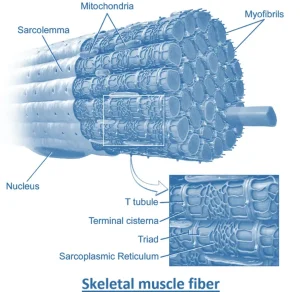- Skeletal muscle is a type of striated muscle tissue responsible for voluntary body movements. It is composed of long, multinucleated cells called muscle fibers.
The structure of skeletal muscle can be understood at various levels:
- Whole Muscle:
- A skeletal muscle is an organ made up of muscle tissue, connective tissue, blood vessels, and nerves.
- The entire muscle is encased in a dense connective tissue layer called the epimysium.
- Fascicles:
- Within the muscle, fibers are grouped into bundles called fascicles.
- Each fascicle is surrounded by a connective tissue layer called the perimysium.
- Muscle Fibers:
- Fascicles contain multiple muscle fibers (muscle cells), which are long, cylindrical, and multinucleated.
- Each muscle fiber is wrapped in a connective tissue layer called the endomysium, containing capillaries and nerves.
- Myofibrils:
- Myofibrils are rod-like structures inside each muscle fiber, responsible for muscle contraction.
- They consist of repeating units called sarcomeres.
- Sarcomeres:
- The sarcomere is the functional unit of a myofibril, defined by the area between two Z-lines.
- It contains thick filaments (myosin) and thin filaments (actin, troponin, tropomyosin), giving skeletal muscle its striated appearance.
- Sarcoplasmic Reticulum (SR) and T-Tubules:
- The sarcoplasmic reticulum (SR) stores and releases calcium ions, which are crucial for muscle contraction.
- T-tubules are extensions of the muscle cell membrane (sarcolemma) that facilitate the rapid
Muscle Tissue
- Muscles are soft tissues that can contract to produce movement or maintain posture.
- There are three main types of muscle tissue:
Advertisements
- Skeletal Muscle:
- Location: Attached to bones by tendons.
- Function: Responsible for voluntary movements.
- Structure: Long, cylindrical, multinucleated fibers with a striated (banded) appearance.
- Smooth Muscle:
- Location: Found in the walls of internal organs and blood vessels.
- Function: Controls involuntary movements, such as the movement of substances through internal passageways.
- Structure: Spindle-shaped, single-nucleated fibers without striations.
- Cardiac Muscle:
- Location: Found exclusively in the heart.
- Function: Pumps blood throughout the body.
- Structure: Branched, cylindrical fibers with one or two centrally located nuclei, striated, and connected by intercalated discs for coordinated contractions.

